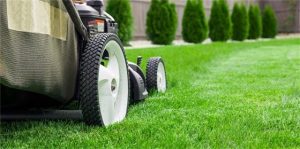Mowing a lawn isn’t always as simple as making sure there’s gas in the mower. Lawns are alive, and treating turfgrass without care can cause problems in the long run. To make sure your lawn is healthy, follow these guidelines.
- Know your turfgrass! Different grasses need to be mowed at different heights. Even the specific variety or cultivar can make a difference, but in general, bahiagrass should be cut to 3-4 inches, bermudagrass to ½ – 1½ inches, centipedegrass to 1½ – 2 inches, zoysiagrass to 2 – 2 ½ inches, and St. Augustinegrass to 2 ½ – 4 inches. Dwarf or finer-leaved varieties are usually cut lower and more often than taller grasses.
- Mow regularly enough to avoid removing more than 1/3 of grass blade height at one time. This makes sure the plant is not overly stressed and can recover from mowing quickly and efficiently, as well as promoting deeper root systems.
- Sharpen mower blades when they start to become dull. Freshly cut grass that has a ragged or torn appearance is a good sign that it’s time to sharpen the blade.
- Pick up debris such as twigs before mowing to avoid damage to the mower blade.
- Avoid mowing if grass is wet. Dew in the early morning or water from irrigation or rainfall will cause grass to clump and stick.
- In uneven lawns, take care to avoid scalping grass when pushing a mower over inclined areas.
- For a truly professional looking lawn, mow in different directions each time you mow. This can help to avoid forming wear patterns.
- Leave clippings on the lawn rather than bagging them. Clippings break down over time, recycling nutrients and adding organic matter. Grass clippings typically do not contribute to thatch buildup. If clumps form, they can be broken up with a rake to evenly distribute the cut grass over the lawn.
- Sweep clippings from hard, impervious surfaces to limit nutrient runoff.
Follow these guidelines and take care with other lawn management such as watering and irrigation, fertilization, and pest and disease control. You’ll have a great looking lawn before you know it!
Latest posts by Evan Anderson (see all)
- Snakes of the Panhandle - October 10, 2025
- Ganoderma, a Deadly Disease of Palms - September 4, 2025
- Watch Your Step, Fire Ants are Out There! - July 27, 2025

